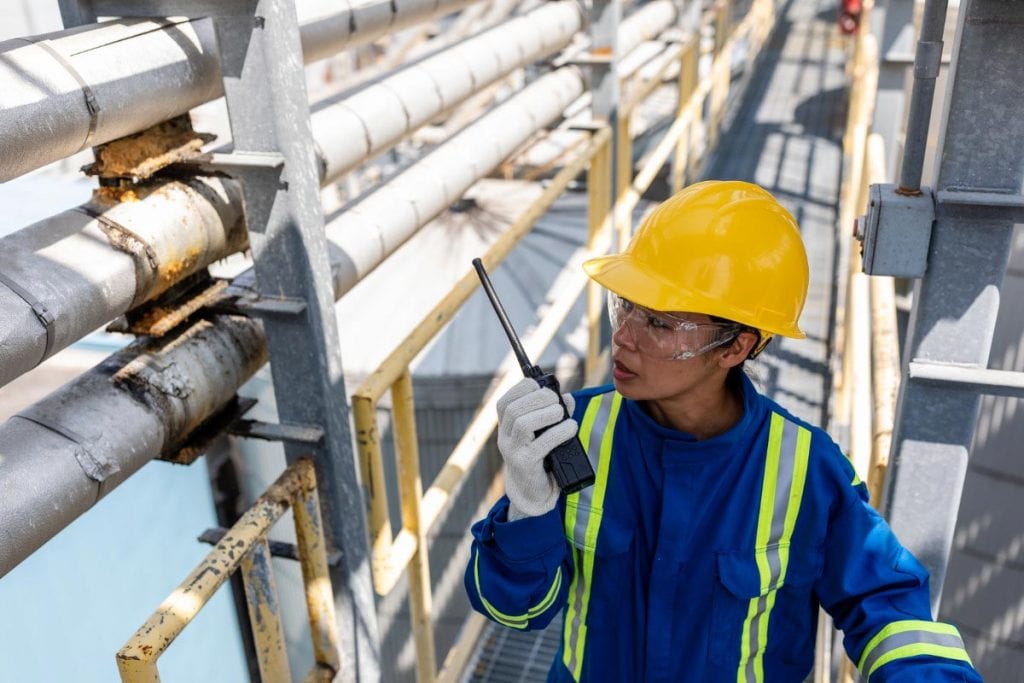Do you know the difference between Wilmington Digital Two-Way Radios and Analog Radios?
Analog two-way radios have been the standard in two-way wireless communication for decades. However, we know times have changed, but luckily, so has technology. Digital communication systems offer advantages that may soon make analog systems less desirable, although likely not completely obsolete. In comparing an analog vs. digital two-way radio communications system in West Berlin, it helps to know the basics.
How Two-Way Radios Work
An analog radio system sends a signal from a large antenna to a smaller one on a radio carrier wave. A worker’s radio transmits a continuous, or sinusoidal, wave, which is soon caught by a receiver in another’s radio. The receiver then modulates the wave, often through frequency modulation (FM), to extract the information we want like voice communication. This can be controlled by a simple chip, which makes analog radios simpler devices that are cheaper to produce.
A digital radio system is similar in that the signal travels from a large antenna to a smaller one and the signal contains information. The difference is that the digital signal does not contain a signal on a modulated frequency. It contains a packet of information sent across a wide range of frequencies, to be reassembled by the receiver. The redundancy in sending so many of these packets over such a wide range makes the signal much more dependable.
Advantages of Analog Two-Way Radios
As mentioned earlier, analog two-way radios are simple and relatively inexpensive. This virtually guarantees they will continue to see widespread use for a long time. These radios use push-to-talk and can scan multiple frequencies, group conversations, and even use limited encryption features.
Analog radios also offer natural voice communication, complete with all the background noise, which is preferred by some users. One advantage of analog radios that will fade with time, or rather, will be matched in time by digital products, is that they are time-tested with proven reliability. Experimentation has led to several features and modifications that make them more useful in specific situations. For example, analog radios are used in alarm systems, PA systems, and other non-personal communication applications in which digital radios are just starting to scratch the surface.
Advantages of Digital Two-Way Radios
To start, a digital two-way radio has all the same basic features as analog radios. What digital can offer that analog can’t is IP connectivity, expandability, and up to a 50% increase in battery life. The latter is because, unlike analog radios, the transmitter in a digital radio is not always on. Digital radios stand by to send pulses of information on demand.
Digital radios work very well with a wide variety of software-driven applications. Digital networks are secure, making it very difficult for others to listen in on transmissions. Perhaps most importantly, digital radio systems offer an extremely reliable signal, comparable even to that of a wired system. The signal is also “cleaner”, canceling out background noise and other unwanted audio. Digital systems can support a larger number of radios over a greater area, as well.
Digital two-way radios can be programmed with several special features. For example, Motorola digital radios can feature:
- A one-touch emergency button that notifies others instantly of a problem
- A Lone Worker feature that sends an alarm if a user doesn’t use the radio in some way for a set period of time
- A fall detection alarm that sends out an alert if a radio detects a worker to be immobile or horizontal for an unusual amount of time
Digital radios also allow better management of individual radios, allowing a manager or controller to do things like:
- Track the location of a given radio
- Send a direct message to a single radio rather than an entire channel
- Send a text message to a radio or group of radios
- Remotely turn a radio on or off or change the channel
- Remotely adjust the volume on a radio
- Lock a radio out of the system when it is reported stolen
- Interrupt the signal from a given radio or radios to allow an emergency message to get through
Moving from Analog to Digital Two-Way Radios in Wilmington
It’s clear to see that a digital radio system offers many more features than an analog one. So, the question is, why isn’t everyone on digital? The answer usually comes down to cost. Some companies don’t see enough immediate benefits to justify the expense of going digital.
The good news is that digital and analog systems coexist very well, sharing much of the same equipment. It is remarkably easy to create a hybrid system or start with an analog system and “grow into” a digital system. Digital signals can be broadcast with the same antenna as an analog system. Many radios and repeaters, including several Motorola repeaters, can run both analog and digital systems.
Digital technology, like all technology, is likely to come down in price as it becomes more prevalent and accepted. It often makes sense for a smaller company to bide their time with an analog system. They can slowly add components to their system that are both digital and analog. They can make the final switch to digital when the price is more aligned with their budget or when the need for more advanced digital features makes it necessary.
You can learn more about digital and analog radios, here, or call us today to discuss options for your business. Armed with knowledge, you can confidently work with Wireless Inc. to create the right Motorola Two-Way Radio communications system for you. Wireless Inc., your premier Motorola Two-Way Radio Dealer in Arlington, Baltimore, Philadelphia, Metuchen, West Berlin, and Wilmington.

